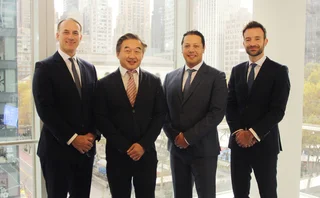
Clearing bank of the year: JP Morgan
Asia Risk Awards 2019

When it comes to clearing in Asia, being the largest entity is not enough. Clients in the region require tailor-made solutions and local expertise to meet local rules, investment and operational models.
JP Morgan, the largest clearing bank in Asia-Pacific, offers that and more. The global behemoth boasts onshore client coverage in most major centres in the region, which brings with it the added benefit of having a team that is well versed in the nuances of the local markets and regulation. Clients also praise the bank’s exchange connectivity, solutions that mitigate capital costs and its readiness ahead of market infrastructure disruptions, such as Mifid or the upcoming Brexit.
“Our existing clients have expanded the products they have been coming to us for,” says David Martin, the Asia-Pacific head of global clearing at the bank. “We have also been able to take advantage of the change in emphasis of the global footprint of some of our competitors. We’ve been there for clients and listened to them for product buildout throughout.”
JP Morgan’s collateral solutions to ease China access, clearing solutions for Asian non-deliverable interest rate swaps (IRS), and services to help clients in their journey towards non-cleared margin rules are among offerings lauded by clients. The bank has also invested in technology to fund expansion in the region, including over-the-counter clearing in Australia, the Korea Omnibus rollout and single stock options in Thailand.
“We are also keeping a close watching brief on the opening of any equity index that may emerge out of China,” Martin says. “One example – we are trying to keep a close dialogue with regulators and exchanges so that we can be as ready as we were for the internationalisation of iron ore and oil futures.”
Volume at its China franchise climbed 30% last year and is seeing a “strong” client pipeline in 2019, he says.
Today, its footprint extends to 15 direct memberships in 10 jurisdictions, from Australia to India. Such a network provides global clients with seamless access to Asia-based exchanges and clearing houses through JP Morgan’s direct connectivity. It also allows the bank to offer inbound access to its non-Asian clients.
By supporting the growth of existing clients and attracting new ones in a market where peers have shrunk, the bank has seen its revenue grow by more than 50% over the past two years. Its initial margin from Asian central counterparties (CCPs) grew by 22% in the past 12 months, the bank says.
We have tailored our offering to ensure clients across Asia can leverage the best of the global model while benefiting from our dynamic, Asia-centric local franchise
David Martin, JP Morgan
“We have tailored our offering to ensure clients across Asia can leverage the best of the global model while benefiting from our dynamic, Asia-centric local franchise,” says Martin. “We offer local, onshore client coverage in Australia and Japan at the start of the global trading day. We have deep experience embedded in our Asia team.”
One factor that has contributed to JP Morgan’s growing clout in the region can be attributed to an in-depth global client survey that it undertakes every two years to home in on areas of improvement and new products. While the clients can respond anonymously, JP Morgan can drill down answers on a regional basis and tailor its strategy to incorporate client feedback.
One example of a product that came largely from client feedback is non-deliverable IRS.
In Asia, JP Morgan’s OTC clearing client base wanted Thailand baht and Taiwan dollar non-deliverable IRS clearing services. The products were introduced to LCH SwapClear’s non-deliverable IRS offering in March 2019.
“Many of our clients now operate a model of clearing both mandated and non-mandated products due to operational efficiencies, counterparty risk and to mitigate capital costs,” he says. “Based on this business case, global resources were allocated to build the capability to support these products at LCH, and JP Morgan was the first to clear these new products on the first day of launch.”
The bank was also one of the first firms to incorporate foreign exchange prime brokerage (FXPB) into its agency-clearing business instead of just aligning it with the bilateral forex business. By supporting both FXPB and forex clearing under the same roof, JP Morgan can save on cost and pass on the benefits to customers, Martin says.
Its FXPB offering provides comprehensive Asia coverage, supporting both deliverable currencies such as the Japanese yen, the Australian dollar, the New Zealand dollar, the offshore yuan, Hong Kong and Singapore dollars and non-deliverable local currencies, such as the onshore yuan, Philippine peso, Indonesian rupiah, Indian rupee, Korean won and Taiwan dollar.
Such an expansive offering is expected to come in handy as the final phases of non-cleared margin rules are implemented and more clients and segments are captured in scope. A vast number of clients are already setting up with the bank to clear non-deliverable forwards in order to ‘future proof’ their business.
Smaller buy-side firms now have an additional year to prepare for the non-cleared margin rules after regulators on July 23 split the fifth phase of rules into two parts, with the new phase six commencing in September 2021.
“We believe clients will increasingly seek FX clearing solutions,” says Martin. “While there has been no regulatory mandate to clear FX, JP Morgan developed an agency-clearing offering at LCH ForexClear in anticipation of rules and balance sheet constraints and associated client demand while retaining a commitment to offer alongside this an FXPB model.”
JP Morgan was the first to go live with forex non-deliverable forward clearing at LCH, driven by client demand in Asia, and is also the largest provider of agency-clearing services at LCH ForexClear.
“We saw the strongest market demand from clients in this region based on the currencies in scope for the LCH offering,” he says. “JP Morgan is actively engaged in the FX clearing marketplace, working together with CCPs, as both a clearer and a dealer, to build out FX clearing and bring additional products such as options clearing, an expanded range of currencies, liquidity and market connectivity to our clients.”
The bank also helped clients navigate the plethora of incoming regulations by undertaking a global roadshow across 14 cities in Europe, Asia and Australia. The roadshow covered the topics of non-cleared margin rules, Brexit, central clearing counterparty recovery & resolution and Mifid II.
These information sessions were aimed at providing practical commentary to help clients think through potential considerations ranging from legal documentation, connectivity, collateral, risk management, levels of asset protection and clearing house margin methodologies. They were particularly well received in Asia where clients can feel somewhat removed from global regulatory dialogue.
Only users who have a paid subscription or are part of a corporate subscription are able to print or copy content.
To access these options, along with all other subscription benefits, please contact info@risk.net or view our subscription options here: http://subscriptions.risk.net/subscribe
You are currently unable to print this content. Please contact info@risk.net to find out more.
You are currently unable to copy this content. Please contact info@risk.net to find out more.
Copyright Infopro Digital Limited. All rights reserved.
As outlined in our terms and conditions, https://www.infopro-digital.com/terms-and-conditions/subscriptions/ (point 2.4), printing is limited to a single copy.
If you would like to purchase additional rights please email info@risk.net
Copyright Infopro Digital Limited. All rights reserved.
You may share this content using our article tools. As outlined in our terms and conditions, https://www.infopro-digital.com/terms-and-conditions/subscriptions/ (clause 2.4), an Authorised User may only make one copy of the materials for their own personal use. You must also comply with the restrictions in clause 2.5.
If you would like to purchase additional rights please email info@risk.net
More on Awards
Clearing house of the year: LCH
Risk Awards 2025: LCH outshines rivals in its commitment to innovation and co-operation with clearing members
Best use of machine learning/AI: CompatibL
CompatibL’s groundbreaking use of LLMs for automated trade entry earned the Best use of machine learning/AI award at the 2025 Risk Markets Technology Awards, redefining speed and reliability in what-if analytics
Markets Technology Awards 2025 winners’ review
Vendors jockeying for position in this year’s MTAs, as banks and regulators take aim at counterparty blind spots
Equity derivatives house of the year: Bank of America
Risk Awards 2025: Bank gains plaudits – and profits – with enhanced product range, including new variants of short-vol structures and equity dispersion
Law firm of the year: Linklaters
Risk Awards 2025: Law firm’s work helped buttress markets for credit derivatives, clearing and digital assets
Derivatives house of the year: UBS
Risk Awards 2025: Mega-merger expected to add $1 billion to markets revenues, via 30 integration projects
Interest rate derivatives house of the year: JP Morgan
Risk Awards 2025: Steepener hedges and Spire novations helped clients navigate shifting rates regime
Currency derivatives house of the year: UBS
Risk Awards 2025: Access to wealth management client base helped Swiss bank to recycle volatility and provide accurate pricing for a range of FX structures







